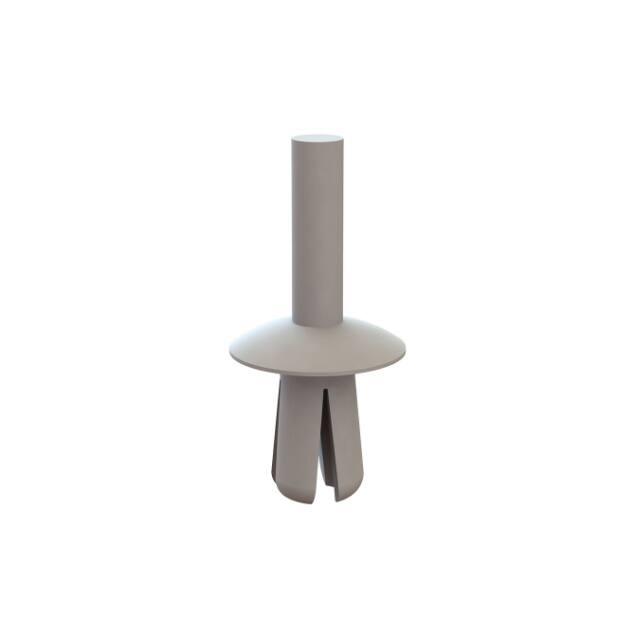NYLON FASTENERS & RIVETS:
How Environmental Factors
Impact Extraction Force
Darren Zellak
�NYLON FASTENERS & RIVETS:
How Environmental Factors Impact Extraction Force
When selecting nylon rivets, snap rivets, or other fasteners, design engineers
should be mindful of the proportionate relationship between the material’s (Nylon
6, Nylon 6/6) moisture content, its tensile strength and ductility. This inherent
tradeoff can result in unanticipated material challenges, as storage and
environmental conditions vary regionally and between production facilities. This
challenge is evident in the divergent extraction force values produced when
testing nylon fasteners with different moisture contents and changes in
temperature.
Can Moisture Content impact extraction forces in nylon
fasteners?
The mean extraction force test results outlined on graph 1 and chart 1, illustrates
how Nylon 6 and Nylon 6/6 fasteners performed with changes in both moisture
content and temperature relative to a baseline of 72° Fahrenheit and a 50%
relative humidity. Interestingly, the same fastener tested in the same hole, varying
only the material’s moisture content, can produce broadly different pull force
values.
In the most extreme example, a very dry fastener with moisture content of 0.67%
produced a relative extraction force 224% higher than that of the same fastener
with a moisture content of 6.74%. Differences in humidity between a product’s
point of production and its point of final use, could lead to premature failure if
variance in moisture content isn’t considered during the application design
process.
Extracting Force Change Relative to 72°F, 50% R.H. Samples
100%
80%
60%
40%
86%
59%
55%
39%
20%
43%
34%
0%
0%
0%
0%
-20%
-29%
-40%
-20%
-21%
-34% -31%
-43%
-60%
Very Dry
Dry
SR-3035B
Nylon 6
72°F, 50% R.H.
ARW020A
Nylon 6/6
Saturated
60°C (140°F)
XT1250125A
Nylon 6/6
1
�Extraction Force Change Relative to
72°F, 50% R.H. / Avg. Moisture Content
Very Dry
Dry
72°F, 50% R.H.
Saturated
60°C (140°F)
SR-3035B
Nylon 6
59% Δ
0.85%
39% Δ
1.60%
0% Δ
3.29%
-29% Δ
7.29%
-21% Δ
3.26%
ARW020A
Nylon 6/6
86% Δ
0.53%
34% Δ
1.34%
0% Δ
2.80%
-34% Δ
6.75%
-43% Δ
2.56%
XT1250125A
Nylon 6/6
55% Δ
0.67%
43% Δ
1.40%
0% Δ
2.72%
-31% Δ
6.74%
-20% Δ
2.37%
What’s the impact in tensile strengths for nylon rivets?
While lower levels of moisture content result in increased tensile strength
(facilitating higher extraction forces), it also results in lower levels of ductility and
impact strength. Since nylon fasteners depend upon the material’s flexibility to
perform (e.g. the limbs of a firtree fastener must flex to pass through a mounting
hole during insertion, before springing back into position on the opposing side of
the panel to facilitate retention. See illustration 1 on page 4.) minimal moisture
content is rarely an ideal condition during the application of the product. It is also
easy to envision how a fastener’s reduced impact strength could result in
premature or unanticipated failure, if not anticipated during design.
Intuitively, one might expect that a substantial increase in the ambient
temperature of the test would adversely affect extraction force. At nearly all
moisture levels, a higher coefficient of variation (CV) was observed than that of
the 72° F control group. The tradeoff is the predictability of the unit’s extraction
force, as illustrated by the extraction force CV values illustrated in graph 2:
Coefficient of Variation Sample
25%
24.54%
23.13%
20%
15%
15.75%
15.50%
13.78%
10%
5%
0%
12.68%
10.56%
4.82%
4.36%
Very Dry
SR-3035B
Nylon 6
4.15%
3.11%
Dry
72°F, 50% R.H.
ARW020A
Nylon 6/6
11.79%
Saturated
XT1250125A
Nylon 6/6
2
�SR Rivet
ARW Rivet
XT Rivet
What practical insight can be extrapolated from this data?
Fir tree fasteners present attractive options for many applications given the range
of panel thickness accommodation, and cost-effective, single-piece construction.
If the point of installation or use is in a dry, hot environment, there may be other
options better aligned with the environment. Without accommodating
environmental and temperature factors, precautions should be taken within the
application to limit stresses which could result in premature failure (e.g. shock
loading).
In examining the load-deflection curves of the SR-3035B, in graph 3, at the
various moisture levels, the tradeoff between predictability and strength is most
apparent in the variation of the points ultimate force of rivets with different
moisture contents.
Extraction Force vs Displacement | SR-3035B
1.8
1.6
1.4
1.2
1
Very Dry
Dry
Equalibrium
0.8
Saturated
0.6
0.4
0.2
0
3
�How to select the best nylon rivets for extreme
environments?
The primary take away is to carefully consider technical attributes, tradeoffs and
the relative cost of options. The careful review of application requirements and
environmental factors at both the point of installation and end use can minimize
the possibility of unforeseen post-production issues.
Ultimately, if a design employs nylon fasteners it’s likely to experience variability
in either temperature or humidity over the course of its expected lifespan, there is
no substitute for a robust testing regime. The regime may include a variety of
other application-based factors, but the fastener’s moisture content should be
one of the baseline requirements in understanding how it will perform over the
product’s expected lifetime.
4
�About the Author
Darren Zellak
Darren is a Senior Engineer with Essentra and holds a B.S. in
Aerospace Engineering and a M.S. in Mechanical Engineering. He
has 25 years of relevant engineering experience and is a principal
designer on 3 patents: Fiber optic cable guide, connector coupling/
decoupling, internal shutter for optical adapter.
�
很抱歉,暂时无法提供与“61PR800000”相匹配的价格&库存,您可以联系我们找货
免费人工找货